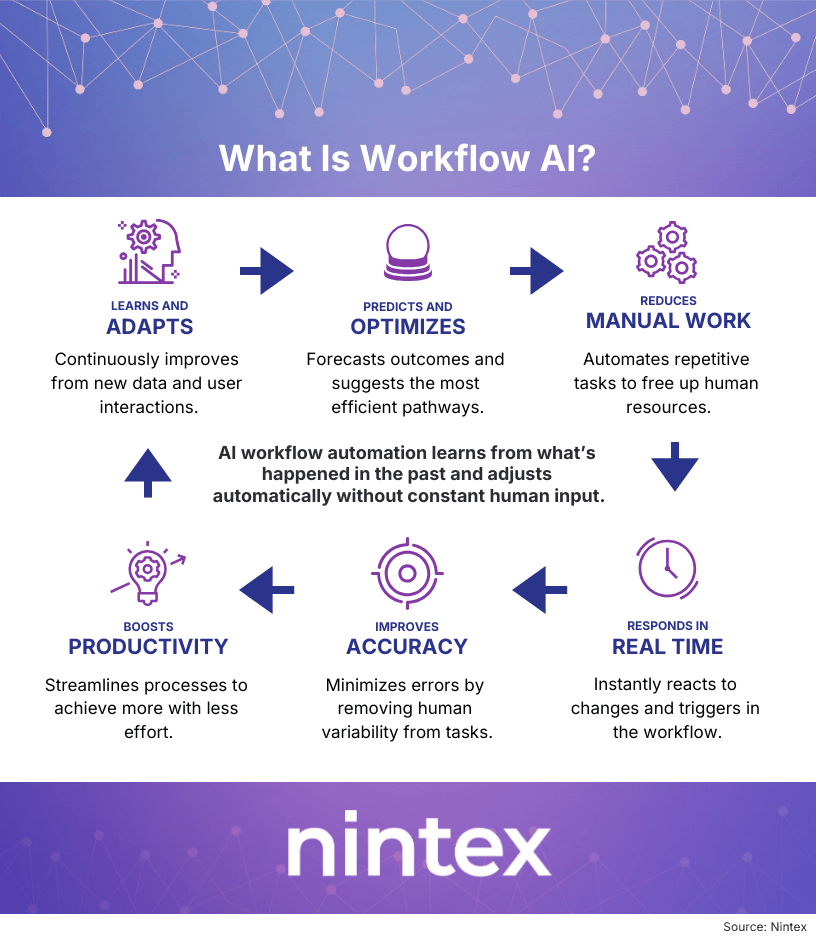Every organization is under pressure to move faster and work smarter. Workflow AI helps make that possible, joining automation with intelligence so your processes actually learn and adapt, not just repeat steps.
With Workflow AI, businesses boost efficiency, improve accuracy, and foster innovation, all while letting teams do more meaningful work. The technology world is moving fast. Understanding what Workflow AI is and how to use it is key to your business’s success.
Understanding Workflow AI

So, what exactly is Workflow AI? It goes beyond simple automation by creating a smarter, more flexible workflow environment that can learn and adapt. By using machine learning and data analysis, AI-powered workflows help businesses run more efficiently and adjust on the fly as conditions change. The result: fewer bottlenecks, smoother operations, and faster responses to market changes in real time.
Traditional workflows are rigid. They follow a set path and usually need people to step in when something changes. AI workflow automation, on the other hand, learns from what’s happened in the past and adjusts automatically without constant human input. That flexibility means teams can shape workflows around how they actually work, not the other way around. Everyday tasks become smoother, faster, and easier to manage.
AI workflow tools also give you a clearer view of what’s happening across your business. You can see where time and resources are going, detect slowdowns, and make better decisions. Companies that use intelligent workflows are working more efficiently while building resiliency and adaptability. In other words, they’re strengthening their competitiveness.
What are the main components of Workflow AI?
Workflow automation AI runs on a few key components that work together to improve business processes. The first piece is solid data input and processing, which pulls information from various systems. When data flows in smoothly and accurately, your AI workflows can respond quickly and make reliable decisions in real time.
Machine learning is the backbone of AI workflow automation, allowing workflows to learn from past data and get better over time. It can predict outcomes, identify patterns, and enable businesses to automate repetitive tasks and optimize resources.
A clear, simple interface makes AI workflows usable. Dashboards, chatbots, and apps ensure that stakeholders can easily engage with AI workflow tools.
All the elements of AI-powered workflows, from data processing to user interaction, can significantly improve business processes.
What are the benefits of Workflow AI?
Implementing Workflow AI can transform how your business runs, making every process faster, smarter, and less manual. By automating repetitive tasks, Workflow AI frees up employees for higher-value projects while also reducing errors and keeping results consistent. This kind of efficiency lifts overall productivity and helps your team focus on what really matters.
Another big advantage of Workflow AI is how much time and money it saves. By cutting down on manual steps, it lowers labor costs and helps teams use their time and tools more efficiently. The result is a smoother operation that wastes less and delivers more.
Workflow AI also gives you the kind of insights you can act on right away. Real-time analytics show what’s working and what’s not. Teams can make smarter decisions. And better collaboration can lead to better overall business outcomes.

How Is Workflow AI used across industries?
Workflow AI is transforming industries everywhere, from healthcare and finance to manufacturing and retail. In healthcare, AI workflow builders handle admin work like patient management, so medical staff can focus on care, not paperwork.
Workflow AI also manages compliance checks in finance, optimizes supply chains in manufacturing, and improves customer service and inventory in retail. By taking over repetitive, error-prone work like data entry and document handling, Workflow AI frees teams to focus on growth and innovation. The result? Faster, more reliable outcomes, from shorter loan cycles to better patient care.
Challenges in Workflow AI implementation
Adopting Workflow AI can be a big win, but it’s not always easy. One of the biggest hurdles is resistance to change. Some employees worry AI will replace their roles. It’s vital to communicate the benefits clearly and provide training to ease this transition.
Data privacy and security are also concerns. As AI manages sensitive data, robust governance policies are essential to ensure compliance with regulations like GDPR. Nintex offers secure solutions to protect your data throughout the workflow process.
Integration can be tough too; legacy systems don’t always mesh tightly with new AI tools. Choosing AI workflow tools that integrate seamlessly with your existing systems makes the transition simple. Nintex helps organizations streamline and scale their processes with minimal disruption.
Choosing the right Workflow AI solution
When choosing Workflow AI tools, look for automation power, strong analytics, and room to customize for your business. These tools should integrate repetitive tasks and minimize errors while providing insights for continuous improvement.
Consider ease of use, scalability, and vendor support. Look for a tool that grows with you, not against you. Nintex makes it simple to build and scale smarter workflows. Its AI-driven tools help your team save time, remove friction, and get more done.
Challenges & solutions
| Problems | Solutions |
|---|---|
| Resistance to change within the organization | Provide comprehensive training and support |
| Data privacy and security concerns | Implement robust data governance policies |
| Integration challenges with existing systems | Choose solutions with seamless integration capabilities |
| High initial cost of implementation | Consider long-term ROI and scalability |
| Limited AI expertise among staff | Partner with vendors offering strong customer support |
Key takeaways
Workflow AI uses artificial intelligence to design, manage, and improve business workflows. It combines automation, data, and human input into one system.
- Workflow AI can help your business automate repetitive processes while adding intelligence that adapts to data and context.
- Traditional automation executes defined tasks, while Workflow AI learns and improves over time.
- The advantage: Workflow AI measurably boosts efficiency, accuracy, and insight.
- Nintex Workflow AI offers teams easy-to-use tools to build smarter workflows that scale and deliver real results.
FAQ
Q. What is Workflow AI?
A. Workflow AI uses artificial intelligence to automate and improve how business processes run, learning from data and adapting in real time.
Q. What’s the difference between Workflow AI and traditional automation?
A. Traditional automation executes fixed tasks. Workflow AI learns from data and context, adapting workflows dynamically.
Q. What are the benefits of Workflow AI?
A. It saves time, reduces errors, improves decision-making, and helps teams focus on higher-value work.
Q. What challenges come with Workflow AI?
A. Common ones include system integration, data privacy, upfront costs, and staff resistance. Address all of these with training, governance, and the right platform.
Q. Why choose Nintex for Workflow AI?
A. Nintex offers intuitive, scalable AI workflow automation tools backed by strong support, making it easy to modernize without major disruption.
Explore these other topics
Nintex Workflow Automation Platform
Webinars on Workflow Automation
Case Studies on Successful Implementations
Nintex Blog for Latest Insights
